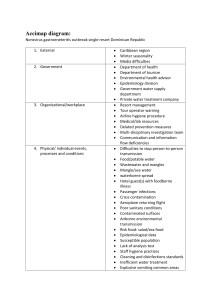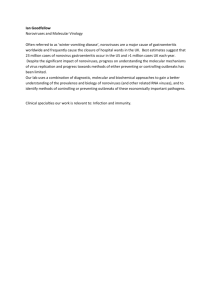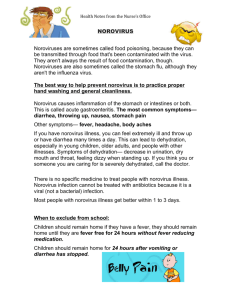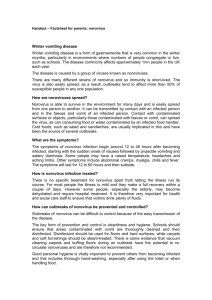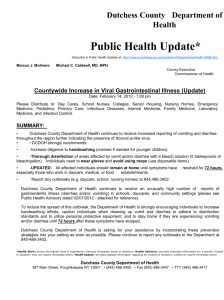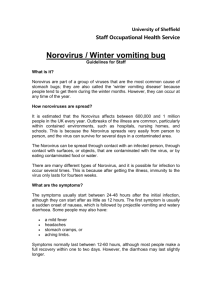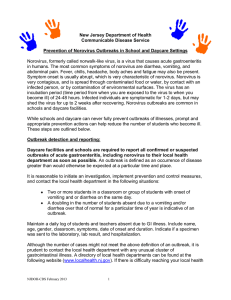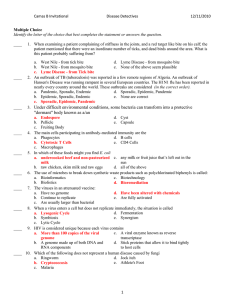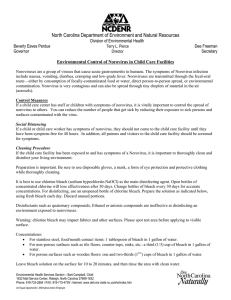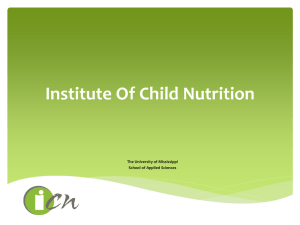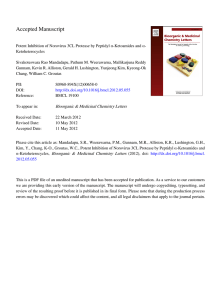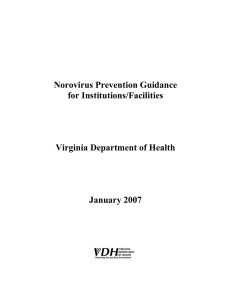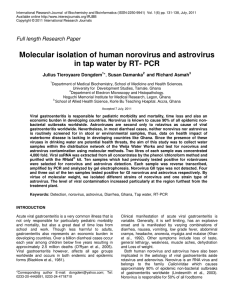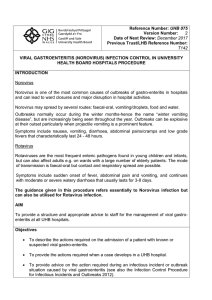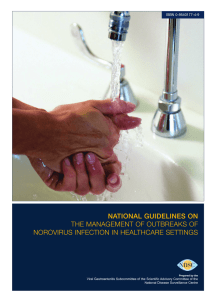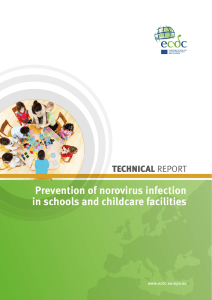Control of Suspected Norovirus Outbreaks in Long Term Care Facilities
advertisement
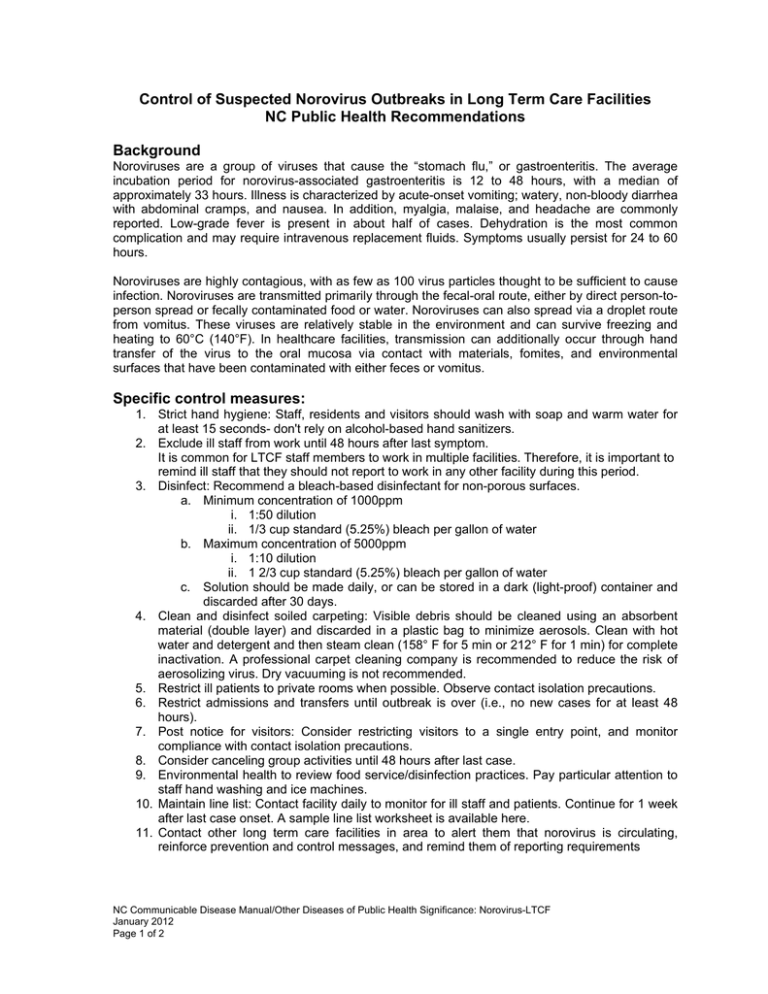
Control of Suspected Norovirus Outbreaks in Long Term Care Facilities NC Public Health Recommendations Background Noroviruses are a group of viruses that cause the “stomach flu,” or gastroenteritis. The average incubation period for norovirus-associated gastroenteritis is 12 to 48 hours, with a median of approximately 33 hours. Illness is characterized by acute-onset vomiting; watery, non-bloody diarrhea with abdominal cramps, and nausea. In addition, myalgia, malaise, and headache are commonly reported. Low-grade fever is present in about half of cases. Dehydration is the most common complication and may require intravenous replacement fluids. Symptoms usually persist for 24 to 60 hours. Noroviruses are highly contagious, with as few as 100 virus particles thought to be sufficient to cause infection. Noroviruses are transmitted primarily through the fecal-oral route, either by direct person-toperson spread or fecally contaminated food or water. Noroviruses can also spread via a droplet route from vomitus. These viruses are relatively stable in the environment and can survive freezing and heating to 60°C (140°F). In healthcare facilities, transmission can additionally occur through hand transfer of the virus to the oral mucosa via contact with materials, fomites, and environmental surfaces that have been contaminated with either feces or vomitus. Specific control measures: 1. Strict hand hygiene: Staff, residents and visitors should wash with soap and warm water for at least 15 seconds- don't rely on alcohol-based hand sanitizers. 2. Exclude ill staff from work until 48 hours after last symptom. It is common for LTCF staff members to work in multiple facilities. Therefore, it is important to remind ill staff that they should not report to work in any other facility during this period. 3. Disinfect: Recommend a bleach-based disinfectant for non-porous surfaces. a. Minimum concentration of 1000ppm i. 1:50 dilution ii. 1/3 cup standard (5.25%) bleach per gallon of water b. Maximum concentration of 5000ppm i. 1:10 dilution ii. 1 2/3 cup standard (5.25%) bleach per gallon of water c. Solution should be made daily, or can be stored in a dark (light-proof) container and discarded after 30 days. 4. Clean and disinfect soiled carpeting: Visible debris should be cleaned using an absorbent material (double layer) and discarded in a plastic bag to minimize aerosols. Clean with hot water and detergent and then steam clean (158° F for 5 min or 212° F for 1 min) for complete inactivation. A professional carpet cleaning company is recommended to reduce the risk of aerosolizing virus. Dry vacuuming is not recommended. 5. Restrict ill patients to private rooms when possible. Observe contact isolation precautions. 6. Restrict admissions and transfers until outbreak is over (i.e., no new cases for at least 48 hours). 7. Post notice for visitors: Consider restricting visitors to a single entry point, and monitor compliance with contact isolation precautions. 8. Consider canceling group activities until 48 hours after last case. 9. Environmental health to review food service/disinfection practices. Pay particular attention to staff hand washing and ice machines. 10. Maintain line list: Contact facility daily to monitor for ill staff and patients. Continue for 1 week after last case onset. A sample line list worksheet is available here. 11. Contact other long term care facilities in area to alert them that norovirus is circulating, reinforce prevention and control messages, and remind them of reporting requirements NC Communicable Disease Manual/Other Diseases of Public Health Significance: Norovirus-LTCF January 2012 Page 1 of 2 Laboratory Testing Testing for norovirus using reverse-transcription polymerase chain reaction (RT-PCR) is available through the North Carolina State Laboratory for Public Health (NC SLPH). This testing is for outbreaks only, and not for diagnosis of individual patients. Requests for norovirus testing must be approved by the Communicable Disease Branch. Specimens from at least five patients must be submitted. One stool specimen from each patient should be placed in Cary-Blair transport medium and kept refrigerated (not frozen) before shipping. Raw stool is acceptable for norovirus testing only, but not for bacterial testing. Specific guidance for specimen collection and shipping are available from SLPH at http://slph.state.nc.us or at (INSERT URL). Please note: Testing for norovirus may not be useful for outbreaks that are clinically and epidemiologically consistent with norovirus and occur in areas where norovirus is known to be circulating. Control measures should never be delayed while awaiting laboratory confirmation. Additional Information North Carolina Statewide Program for Infection Control and Epidemiology (NC SPICE) at: http://www.unc.edu/depts/spice/gastroenteritis.doc. NC Communicable Disease Manual/Other Diseases of Public Health Significance: Norovirus-LTCF January 2012 Page 2 of 2
